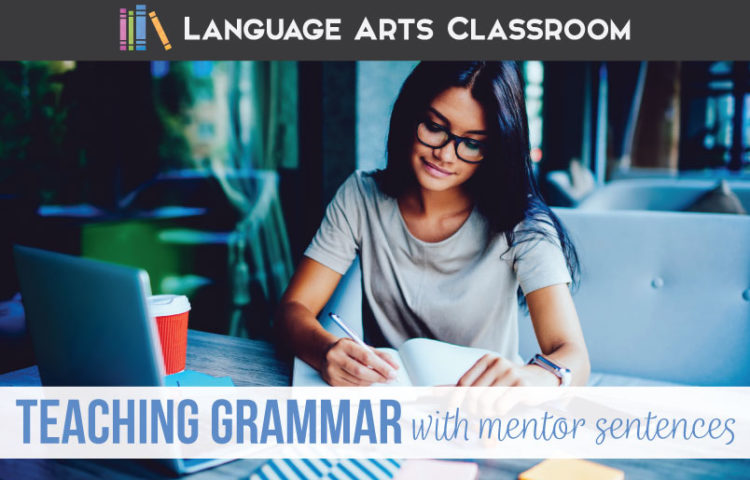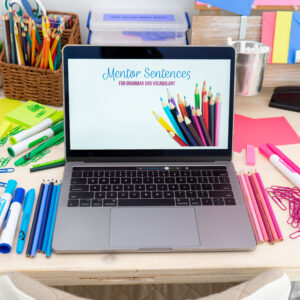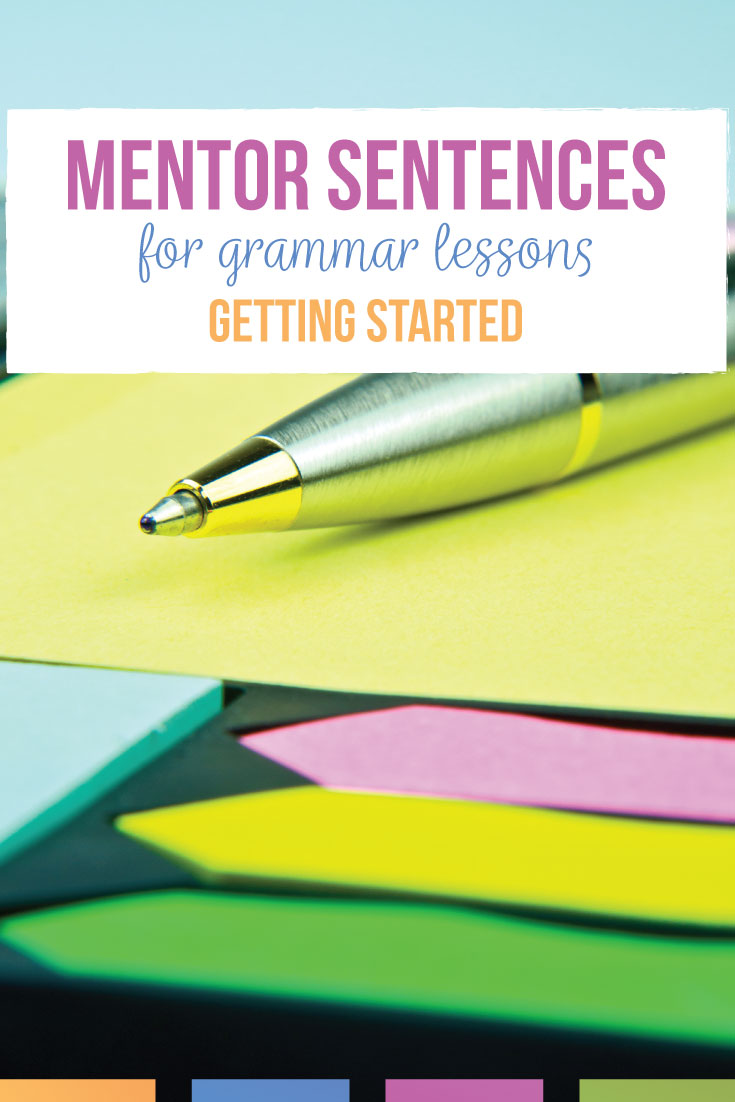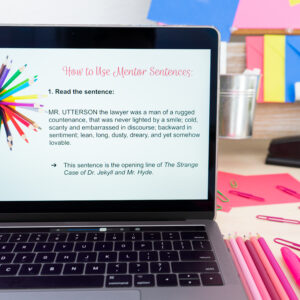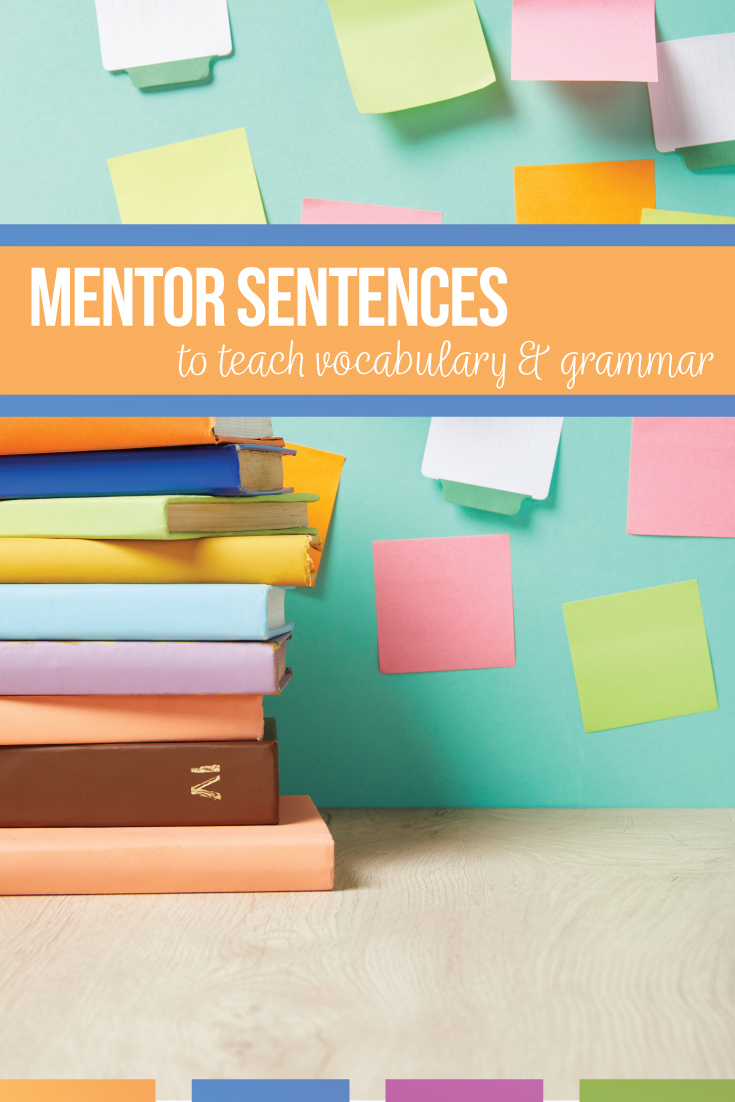No matter what you call them—grammar mentor sentences, practice sentences, master sentences from literature—using sentences from literature is a powerful tool. Teaching with mentor sentences to meet language and grammar standards is an engaging practice.
The majority of my time as a student, I found grammar boring, and the assignments held little meaning to me. I completed them and forgot them. When I began teaching, I struggled the same way with grammar. Teaching with grammar mentor sentences changed my approach.
I think my desire to teach my students grammar in a non-boring fashion drove me to create grammar mentor sentences: taking grammar from literature. My third year in my ELA classroom, I began pulling sentences from a variety of stories to analyze. I found this to be a natural approach to grammar. Studying sentences from novels, plays, nonfiction, and everyday dialogue was fun.
Using grammar mentor sentences allows students to be invested in language because they will be looking at words they’ve already read, and hopefully this gives students a connection.
What does the research say?
Students will understand that what they read is what they study in grammar. Plus, this is the suggestion from the National Council of Teachers of English (NCTE).
NCTE includes this idea in their Guidelines about Grammar:
People associate grammar with errors and correctness. But knowing about grammar also helps us understand what makes sentences and paragraphs clear and interesting and precise. Grammar can be part of literature discussions, when we and our students closely read the sentences in poetry and stories. And knowing about grammar means finding out that all languages and all dialects follow grammatical patterns.
For years I’ve approached grammar from the viewpoint that it is more than practice and review; it is a part of what students normally do in their English classes. (To get to that point, we often have to do practice and review, but I always let students know we are working toward this goal.) Using mentor sentences to teach grammar emphasizes the idea that grammar and language have many levels. We are actively moving from recognition to creating and analyzing.
Students appreciate studying grammar and language from what they are already reading. Below, I’ve included ideas about the benefits of mentor sentences, as well as how to get started with mentor sentences.
What are mentor sentences?
Grammar mentor sentences are almost like model sentences. Since professional writers edit and revise, and then have other professionals edit and revise those sentences, why shouldn’t we study those sentences?
To begin teaching with mentor sentences, find engaging sentence that demonstrate complex pieces of language. As you read, look for areas that students often need review. Basically, find those concepts in use! Then, as you teach those areas, you can add authentic sentences as examples. When I read any piece of writing, I typically look for sentences that contain:
- Parallelism.
- Tricky subject and verb agreement.
- A variety of sentence structures.
- Punctuation use.
If you need more ideas for what concepts to look for in mentor sentences, check out your language standards. Put the list on a sticky note, and use the sticky note as your bookmark. Add page numbers when you find an example that will help you teach your language standards.
How can I use mentor sentences effectively?
How can ELA teachers implement mentor sentences and practice grammar in the context of literature? Hopefully, teachers can personalize the idea for all of their classes and for students’ needs. Here are ideas though:
- Find mentor sentences ahead of time. Choose the sentences, present them to the class, and study a specific grammatical concept, such as different types of conjunctions. You can make the presentation ahead of time, or you can add the mentor sentences to your grammar lessons. This method is low-stress.
- Choose specific passages. Looking at published authors’ words shows students that a knowledge of grammar enhances their writing. A large paragraph can start discussion with students regarding connotation and denotation as well as overall effects of language. This method requires a bit of thinking on your feet as you will not know in advance how the conversations will develop. The conversations, however, can be rewarding.
- Ask students to choose sentences! Give them the power for choosing mentor sentences. Have students choose a sentence and deconstruct it (look at parts of speech, parts of a sentence, types of sentences, etc.), OR have students choose a sentence knowing in advance the grammar tool they will be analyzing. This method of teaching with mentor sentences allows for differentiation, but the teacher must be ready to be unsure in front of students. If you are not sure of an answer, tell students. Consult other teachers and circle back to the conversation the next class period.
Of course, this requires a piece of writing and maybe pencil and paper. If you are wanting organizers specific to grammar mentor sentences, I have a free set ready for you. That set works well for identifying grammatical parts of sentences. Teaching with mentor sentences can be rewarding; you have to find the method that will work for you and students.
When do I teach mentor sentences?
Mentor sentence lessons fit in the pieces of your middle school or high school teaching time. Mentor sentence work will work in a variety of ways.
The first way is with writing lessons. A mentor text can teach grammar rules, interesting sentence variations, descriptive words, and other important skills for students to apply to their own writing.
The second way is with spiral learning. As you rotate through language standards and through skills, mentor sentences can provide examples of the language skills you are covering.
Finally, my high school mentor sentences routine involves bell ringers. My students and I simply work through a sentence a day. We experiment and play too. For instance, we might take simple sentences and change them to complex. Next, we’ll critique the author’s style and apply aspects to student writing.
The only way to make sure students know what to do with sample texts is to have a mentor sentence routine. Here is mine:
How do I implement mentor sentences?
You have sentences, you have standards you want to meet, now what?
Don’t stress. Using the sentences to support your other lessons will help students. Teaching with mentor sentences does not need to be a huge process!
However, if you are wanting to dive deeper into language, I created a process for looking at sentences from a grammatical standpoint with students. I included the questions below, along with example from The Great Gatsby.
I complete these questions with students to set the expectations for language analysis.
Look at the sentence:
“Whenever you feel like criticizing any one,” he told me, “just remember that all the people in this world haven’t had the advantages that you’ve had.” This quote is from the start of the book that the narrator (Nick) is recalling.
To begin teaching with mentor sentences in an analytical way, ask students what they recognize. You can even ask students if they like the sentence, and why.
Deconstruct it: Find grammatical concepts, as well as literary terms used.
This sentence has three dependent clauses, and one independent clause. It has phrases too. Plus, it is a longer sentence and a complex sentence.
It is also a quote, so it speaks naturally, as a person would talk to a relative.
If I were to use this quote in a creative writing unit, I would point out how the “he told me” is in the middle of the quote. We would take notes on using commas and quotation marks. Be creative with your mentor sentences! Use them in many ways.
Find the message. (It helps to look at the sentence in the context of the book.)
The sentence’s message is fatherly advice. Nick’s father tells him that he has advantages, and that other people may behave a certain way because they lacked advantages.
Then, ask students if the vocabulary or the construction contributed to the impact of the message. (The novel has fantastic models of figurative language too.) Students might note that the use of commas enhances the pauses, making the message a bit more dramatic and fatherly.
Tie the meaning to the language.
The sentence construction matches the message. It is a deep message, one that can be applied to numerous aspects of life. Each dependent clause provides emphasis, and the information builds as the sentence continues.
Tie vocabulary or other language concepts to the discussion. Do certain words have a strong connotation? What is the effect of the author using a string of adjectives? The more you discuss language with students, the more grammar will make sense to them. Using domain-specific vocabulary with mentor sentences greatly enhances students’ remembering of those terms.
What activities do I use?
My biggest piece of advice when teaching grammar: Teach grammar like any other piece of your ELA curriculum. Direct instruction, one-pagers, graphic organizers, worksheets, task cards: Anything that you use to teach other parts of class should be what you use with grammar! Which—yeah, is why grammar mentor sentences work.
For instance, I ask students to explore young adult literature with a one-pager. Students explore adjectives, but they also interact with an assortment of books. I’m working on multiple goals (grammar and independent reading) at the same time. Plus, I’m showing students that language is already a concept they use.
Another option is to use an online book from the public domain. I use Little Women because many of my students are familiar with that story and after looking at the sentences, students read (or reread) the book.
Basically, I have not found a poor choice for grammar mentor sentences from literature. If you are nervous that students will choose sentences that you’re uncomfortable analyzing, choose them ahead of time. Students will understand their reading in new ways from these grammatical discussions.
What else about grammar mentor sentences?
Students still need a basic knowledge of grammatical terms and their definitions. Students may need practice identifying and recognizing word patterns, sentences, and locations. Hopefully, the practice of using grammar mentor sentences in addition to basic understanding involves students. Higher order thinking skills can especially work with mentor sentences as I ask students to reflect on the sentences, to mimic the sentences, and to apply concepts from direct instruction to the mentor sentences.
As I teach books numerous times, I add to the my grammar mentor collections. Many of my bundles contain too many activities for realistically teaching to one class. This perfectly allows teacher to adjust to students’ needs.
As grammar has returned to the classroom, teachers have a unique opportunity to show learners that grammar is not boring, that it needn’t be feared. Mentor sentences can help teachers accomplish that; they can show classes that when they read, they are naturally studying grammar. Using mentor sentences to teach grammar will increase student understanding and engagement.
Are you looking for support with examples of mentor sentences and sentence structure in literature? Join my Facebook group, Grammar Gurus. We discuss all ideas grammar, include mentor sentence examples!

